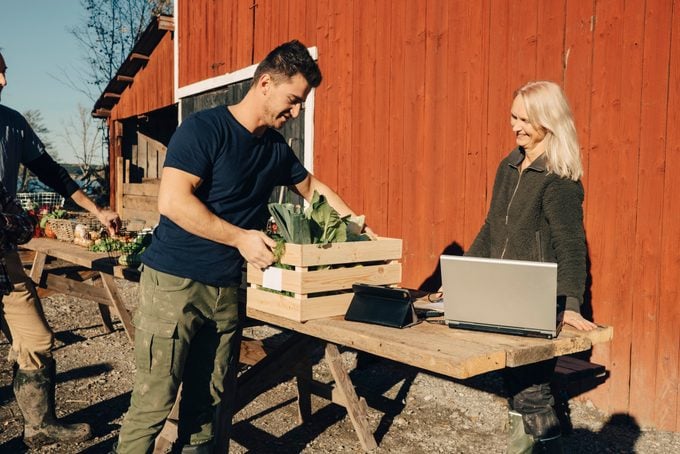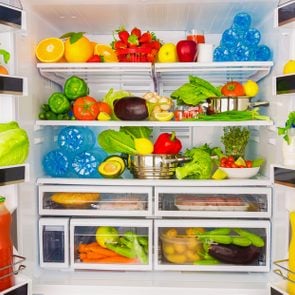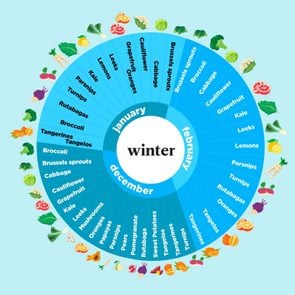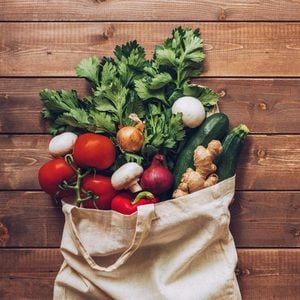This Is What a CSA Box Is—and 7 Ways It Can Improve Your Health
Updated: May 05, 2021
Got questions about community-supported agriculture? CSAs are a great way to get locally-grown produce, support local farms, and make your meals more nutritious.
What is CSA?
Eating fresh, just-picked produce that has recently been harvested is easier to do if you have access to fruits and vegetables locally grown by farmers in your region.
While supermarkets may have all types of produce available year-round, that doesn’t mean that they are actually in season.
Tasting a tomato right off the vine or a sun-ripened peach off the tree may signal a certain time of year—summer—but it’s also when the flavor will be at its peak.
Joining a community-supported agriculture program, or CSA, is one of the best ways to buy directly from a farmer and receive freshly picked produce that is currently growing in your region.
You can get a CSA box that’s full of produce that is often picked the same day, offering a peak of freshness straight from the fields.
“They allow you to get produce directly from a local farm, so your part of a community and you get access to the best, freshest seasonal produce,” explains Abbie Gellman, registered dietitian and chef at the Institute of Culinary Education.
(These are the produce mistakes you should avoid.)
Fresh picked produce just for you
A CSA “makes the connection to food smaller,” says Holly Klamer, a Michigan-based registered dietitian nutritionist. “You are able to see where food comes from, put a face with where it comes from, and recognize the value of farmers. The benefits are not just nutritional but environmental and social as well.”
The idea of a CSA can be similar to a co-op but it’s a farm version. The idea is that you’re investing in the farm and in exchange, as a “member” or customer, you receive a box of veggies and fruits.
The cost of joining a CSA varies by farm, but annual costs can range from $400 to $700 and are usually paid upfront, according to NC State University Extension. This depends on the duration of the harvest season and how much variety and quantity of products you’re getting. This is done so the farm has financial resources ahead of time since there are costs and labor involved before crops are ready to harvest.
Eating in season becomes natural and easy because what you receive is what is currently growing on the farm.
You can typically sign up to receive a box weekly, bimonthly, or monthly. Sometimes you can choose a small or big box and there is often an option to choose value-added items, such as eggs, honey, flour, or grains if the farm produces those, too.
Bigger CSAs, often ones that are like a middleman in connecting farms to customers, may offer delivery straight to your doorstep and there may also be an option to select specific types of produce that most farms can’t offer due to logistics.
Typically, farms have drop-off areas where you can pick up your box during a select time frame on a specific day.
If you’re curious about subscribing to a CSA you can check the USDA listing, local harvest, or visit your nearby farmers’ market and ask farmers if they also offer CSA boxes.
Here are just some of the health benefits of joining a CSA, according to nutritionists.
(Look out for the signs that farmer’s market produce isn’t fresh or local.)
An easy way to eat more fruit and veggies
Nutritionists are often encouraging people to eat more fruits and vegetables every day.
Receiving a CSA box can be an easy way to have more produce at home, making it easier to add more produce into your dishes and snacks.
“In general, having handheld fruit on hand, such as apples, pears, bananas, stone fruit, etc., helps increase consumption because they are easy to eat and take on the go,” says Gellman.
When you have produce at home, it makes it more convenient and more likely to add it to your diet. “Having veggies available definitely helps make them more accessible and integrated into meals and snacks, says Gellman.
When we have an array of produce available, there is a tendency to eat it and find ways to use it.
“It’s also usually a larger quantity of produce than most people buy which means you are more likely to include a fruit or vegetable with a meal and meet the daily recommendations for fruits and vegetables,” says Jodi Greebel, RDN and nutrition consultant.
Preparing in advance can make eating more fruits and veggies a lot easier and can make snack time and meal planning simpler,” she adds.
Her tips are to wash and cut some fruits and vegetables (when you are in the mood) and keep them in see-through containers.
“For example, have a bowl of grapes washed and ready to eat in the fridge. Eliminate any hurdles that make it harder to eat these foods when you are hungry,” Greebel explains.
In one study, researchers provided subsidized CSA boxes to low-income households and found that both adults and children increased their intake of fruit and veggies by simply having access to fresher produce. (The study was published in the journal Nutrients.)
Check out how to get a prescription for free produce.
The produce is nutrient-dense
When you buy produce through a CSA, it’s often harvested the same day that you receive the box.
Farmers pick crops at their peak when they’re ready to eat instead of harvesting the produce when it’s green, weeks before it ripens. When produce has to travel long distances, it must be picked early; if growers picked it while ripe and then shipped it, the produce would be well past its prime by the time it made it to store shelves.
“Food is the most nutrient-dense right after it is picked. Many nutrients in the food start to decrease in amount the longer it is off the plant,” says Greebel.
Eating in season and purchasing food directly from a farmer minimizes travel distance and time and means you have access to fresh fruits and vegetables soon after they’ve been picked.
“When you consume fresh produce in season, within hours of harvest, you often get the best the plant has to offer—flavor and nutrition. It hasn’t been prematurely picked to better handle the long transportation and storage requirements of large-scale retail environments,” says Stacey Krawczyk, RD, and principal consultant for the Grain Foods Foundation and founder of Foodwell Strategies.
“CSA produce is often harvested at peak ripeness; it is not picked prematurely. This means produce stays on the plant longer to get nutrients from soil, sun, vine, etc,” says Klamer.
(Don’t miss these secrets your farmer’s market isn’t telling you.)

Try new types of veggies
One of the advantages of eating in season and getting a box means you’ll likely get fruits and vegetables you haven’t seen before.
“Some produce may never make it to a grocery store, which can keep it off your radar until it lands in your box,” says Greebel.
“Kohlrabi is generally not found at grocery stores, but it is widely distributed in CSAs,” says Gellman. “The first time I had it was because of my CSA share—and now I look forward to it every year!”
CSAs are great for exposing people to new options, says Greebel. But when it comes in a CSA box, people are more likely to find a way to consume it, whether it’s looking for recipes or finding a way to experiment with it.
“I often have clients asking what a food is or Googling recipes for ingredients they receive in a CSA box,” says Greebel. Even if you’re familiar with a fruit or vegetable, it’s possible that there are types you’ve never seen or tasted before.
In a 2015 study, researchers mailed 151 questionnaires to rural New Yorkers and found that people in CSAs have tried at least one new vegetable, highlighting the importance of exposure and access.
The study—published in Public Health Nutrition—concluded that “the CSA experience has the potential to enhance vegetable exposure, augment vegetable preference and increase overall vegetable consumption.”
Richer flavor
Vegetables can easily be on the list of the least favorite things to eat for many, kids and adults alike, but one factor that people may not consider is taste. Flavor is directly influenced by when a crop is harvested.
The recently picked produce in your CSA will taste different than the stuff you get at the grocery store, says Krawczyk. “Many of these foods are picked at the peak of their flavor.” That means you’re more likely to actually eat it, says Krawczyk.
You may even find yourself enjoying vegetables you thought you didn’t like because you never had it in season. “Produce tastes better when it is grown at the appropriate time of year with the right conditions and nothing is being used to help it along with growth,” says Greebel.
“Getting fruits and veggies that are picked at their peak and not traveling far to reach you will give you more nutrition and definitely better flavor and texture. I dream of summer peaches and tomatoes!” adds Gellman.
(Here are what nutritionists consider the most filling fruits and vegetables.)
Experiment with fresh herbs
You’ll often get fresh herbs like cilantro, rosemary, thyme, basil, and sage in your produce box and can be another way to expand and incorporate new foods into meals.
“Having herbs in a CSA box can help encourage people to try new herbs because they are right there, they do not have to make the choice to buy them,” Klamer says.
Herbs can be an additional source of nutrients. “Because herbs are a plant, they are also packed with vitamins, minerals, and antioxidants, so they are a great source of nutrition,” says Greebel.
Antioxidants are compounds that help the body fight harmful molecules known as free radicals.
“Many herbs also have plant compounds that can also provide healthy contributions to our diets,” says Krawczyk, “so fresh herbs are a great addition to pasta, pizza, bread, and even water!”
Plus, herbs offer a healthy way to add flavor to your dishes. “You can season your food without adding salt, calories, or fat, which is how food is often seasoned in the United States,” says Greebel.
(Here’s how to grow indoor herbs and veggies.)
Overwhelmed? You can freeze some for later
If you have a week where you aren’t sure how you’ll be able to eat all produce, consider freezing some of it for later.
Freezing vegetables can be a good way to retain their nutrients, explains Gellman. “When vegetables are picked and frozen at peak, the nutrition value would be similar” to eating fresh, she says.
Note that there’s a trick to freezing produce properly—learn more about that here.
Cook more at home
Preparing meals at home instead of eating out in restaurants and casual food establishments is healthier for you since you know exactly what is in your food, including the amounts of ingredients.
“[CSA’s] can encourage vegetable-focused meals at home which is healthier than eating out,” Klamer says. Your produce box may even contain ideas for different ways to use the ingredients—a fun way to experiment and add variety to your meals.
“Often CSAs will provide recipes and tips on how to prepare and serve novel items,” says Krawczyk.
Whether cooking is a fun endeavor or more of a chore, trying out new fruits and vegetables can make preparing a recipe more interesting.
There is a tendency for those who subscribe to a CSA to become more adventurous with their meal planning.
“CSA members are often already comfortable in the kitchen,” says Gellman. “At the very least, they enjoy the process of trying new recipes and looking for ways to use different foods.”
Next, try these ready-to-eat vegan delivery services.



